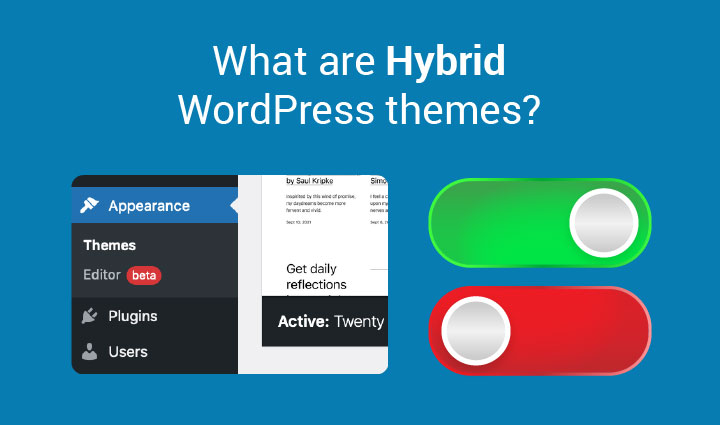16 February 2023 James Koussertari

Since the introduction of the block editor in WordPress 5, things have been moving very quickly in the WordPress space. With so many new features being added in every release, it can be difficult to keep up with all the changes.
WordPress themes in particular have evolved a lot in recent years. Block themes, FSE themes, Hybrid themes, Universal themes, are just some of the buzz words you’ve probably been hearing lately.
To effectively answer the question “what are hybrid themes”, it is necessary to have an understanding of all types of WordPress themes, so that their differences can be more easily identified.
Classic WordPress themes have been around for a long time. You’ve probably used one if you’ve ever used WordPress before. You might even be using one today, as they are still the most popular type of WordPress theme.
Classic WordPress themes are pre-designed website templates which usually come with specific features and functionality.
They usually include features such as editable headers, sidebar widgets and customisable colour schemes.
Classic themes are usually paired with a page builder plugin like Elementor, Divi, Avada or WP Bakery. Page builders have always been the solution to the lack of features in the standard classic editor.
Block Themes are revolutionising the way in which we can build websites in WordPress. They are specifically created to work with the Block Editor and enable Full Site Editing features.
Full Site Editing (FSE) enables users to customise the design and layout of their entire website. With FSE, users can modify elements such as the header, footer, post templates, archive pages, and other areas that were previously restricted to code based editing.
Block themes provide pre-designed patterns and custom block styles, making it easier for users to create content with minimal effort.
FSE themes are exactly the same as block themes. People tend to use these names interchangeably, although ‘block themes’ is now the official and preferred title. FSE stands for full site editing, hence why these types of themes originally got their name.
Going forward, full site editing describes the overall experience of using the block and site editor, while a block theme is what sets up the default styles, patterns, blocks, constraints and demo content.
A universal theme is compatible with both editing modes, full site editing and classic editing. It allows users to build a site using the classic mode and later switch to FSE mode when they feel the Site Editor is more mature.
A universal theme may be considered a safe bet during this transition period if you’re not quite ready to take the plunge.
Any changes made to the theme in classic mode should also be reflected when the Site Editor is enabled.
Hybrid WordPress themes are a combination of traditional classic themes and block-based themes. They provide a mix of the classic editing experience that many users are familiar with, while also taking advantage of the new features and capabilities offered by block-based themes.
In other words, hybrid themes allow users to work with blocks to build custom page designs, while also maintaining access to the traditional WordPress editor.
Hybrid themes can make it easier for users to transition to the new block-based editor, while still providing the flexibility to work with familiar tools and features.
Some of the benefits of hybrid themes include:
The introduction of the block editor in WordPress 5 has led to rapid changes in the WordPress space, including the evolution of different types of themes:
Classic themes are pre-designed templates, usually paired with a page builder plugin.
Block themes are specifically created to work with the Block Editor and enable Full Site Editing features.
FSE themes are the same as block themes and allow users to customise their entire website.
Universal themes are compatible with both classic and FSE editing modes.
Hybrid themes are a combination of traditional and block-based themes, providing a mix of the classic editing experience with the new features and capabilities of block-based themes.
Armed with this knowledge, we hope you can now make an informed decision when choosing your next WordPress theme.
16 February 2023 James Koussertari